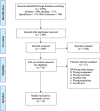Effects of Cardiorespiratory Fitness on Cerebral Oxygenation in Healthy Adults: A Systematic Review
- PMID: 35309063
- PMCID: PMC8931490
- DOI: 10.3389/fphys.2022.838450
Effects of Cardiorespiratory Fitness on Cerebral Oxygenation in Healthy Adults: A Systematic Review
Abstract
Introduction: Exercise is known to improve cognitive functioning and the cardiorespiratory hypothesis suggests that this is due to the relationship between cardiorespiratory fitness (CRF) level and cerebral oxygenation. The purpose of this systematic review is to consolidate findings from functional near-infrared spectroscopy (fNIRS) studies that examined the effect of CRF level on cerebral oxygenation during exercise and cognitive tasks.
Methods: Medline, Embase, SPORTDiscus, and Web of Science were systematically searched. Studies categorizing CRF level using direct or estimated measures of V̇O2max and studies measuring cerebral oxygenation using oxyhemoglobin ([HbO2]) and deoxyhemoglobin ([HHb]) were included. Healthy young, middle-aged, and older adults were included whereas patient populations and people with neurological disorders were excluded.
Results: Following PRISMA guidelines, 14 studies were retained following abstract and full-text screening. Cycle ergometer or treadmill tests were used as direct measures of CRF, and one study provided an estimated value using a questionnaire. Seven studies examined the effects of CRF on cerebral oxygenation during exercise and the remaining seven evaluated it during cognitive tasks. Increased [HbO2] in the prefrontal cortex (PFC) was observed during cognitive tasks in higher compared to lower fit individuals. Only one study demonstrated increased [HHb] in the higher fit group. Exercise at submaximal intensities revealed increased [HbO2] in the PFC in higher compared to lower fit groups. Greater PFC [HHb] was also observed in long- vs. short-term trained males but not in females. Primary motor cortex (M1) activation did not differ between groups during a static handgrip test but [HHb] increased beyond maximal intensity in a lower compared to higher fit group.
Conclusion: Consistent with the cardiorespiratory hypothesis, higher fit young, middle-aged, and older adults demonstrated increased cerebral oxygenation compared to lower fit groups. Future research should implement randomized controlled trials to evaluate the effectiveness of interventions that improve CRF and cerebral oxygenation longitudinally.
Keywords: cardiorespiratory fitness; cerebral oxygenation; cognition; exercise; functional near-infrared spectroscopy; older adults; younger adults.
Copyright © 2022 Salzman, Dupuy and Fraser.
Conflict of interest statement
The authors declare that the research was conducted in the absence of any commercial or financial relationships that could be construed as a potential conflict of interest.
References
-
- Ainslie P. N., Cotter J. D., George K. P., Lucas S., Murrell C., Shave R., et al. (2008). Elevation in cerebral blood flow velocity with aerobic fitness throughout healthy human ageing: Cerebral blood flow and aerobic fitness. J. Physiol. 586 4005–4010. 10.1113/jphysiol.2008.158279 - DOI - PMC - PubMed
Publication types
LinkOut - more resources
Full Text Sources
Miscellaneous


